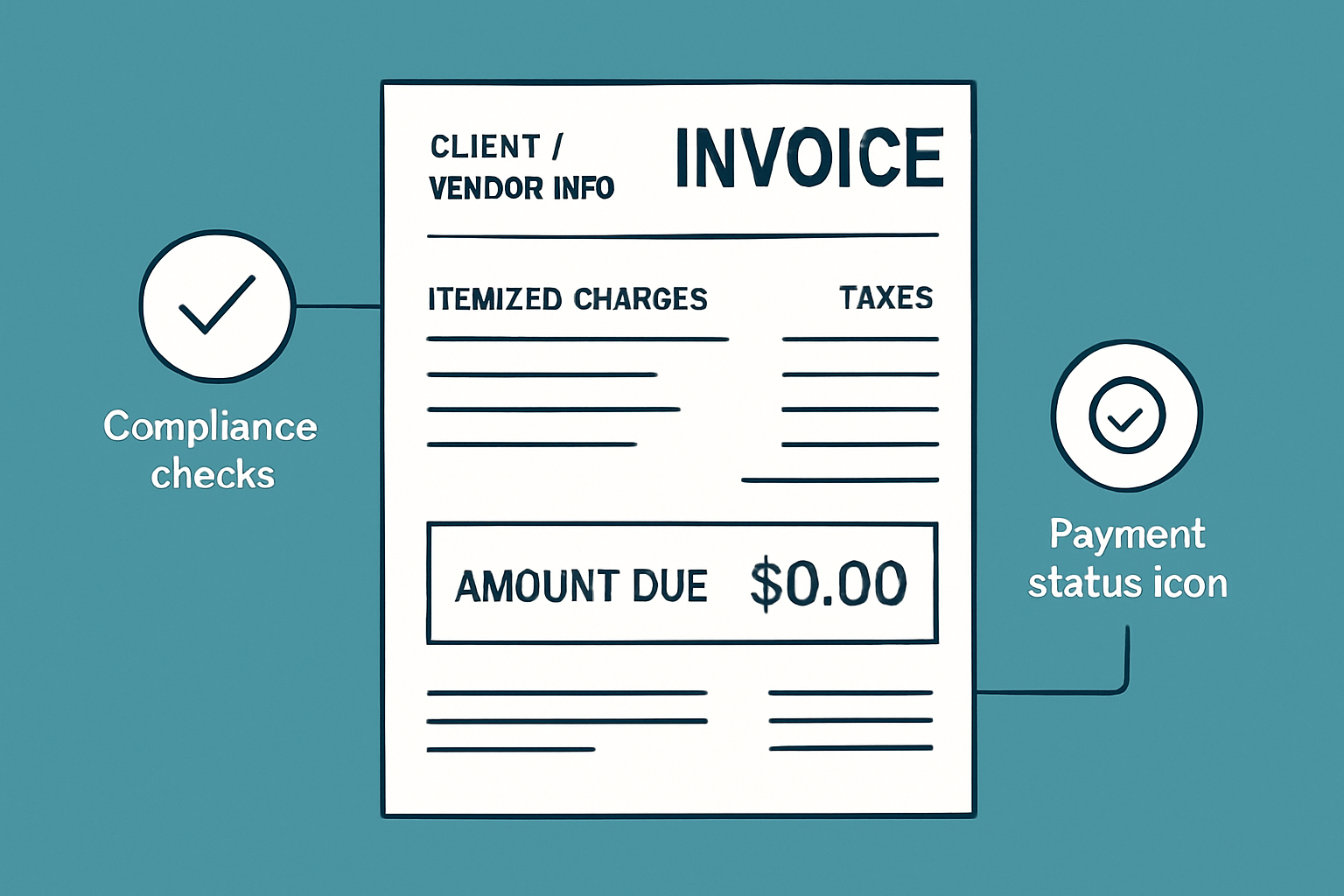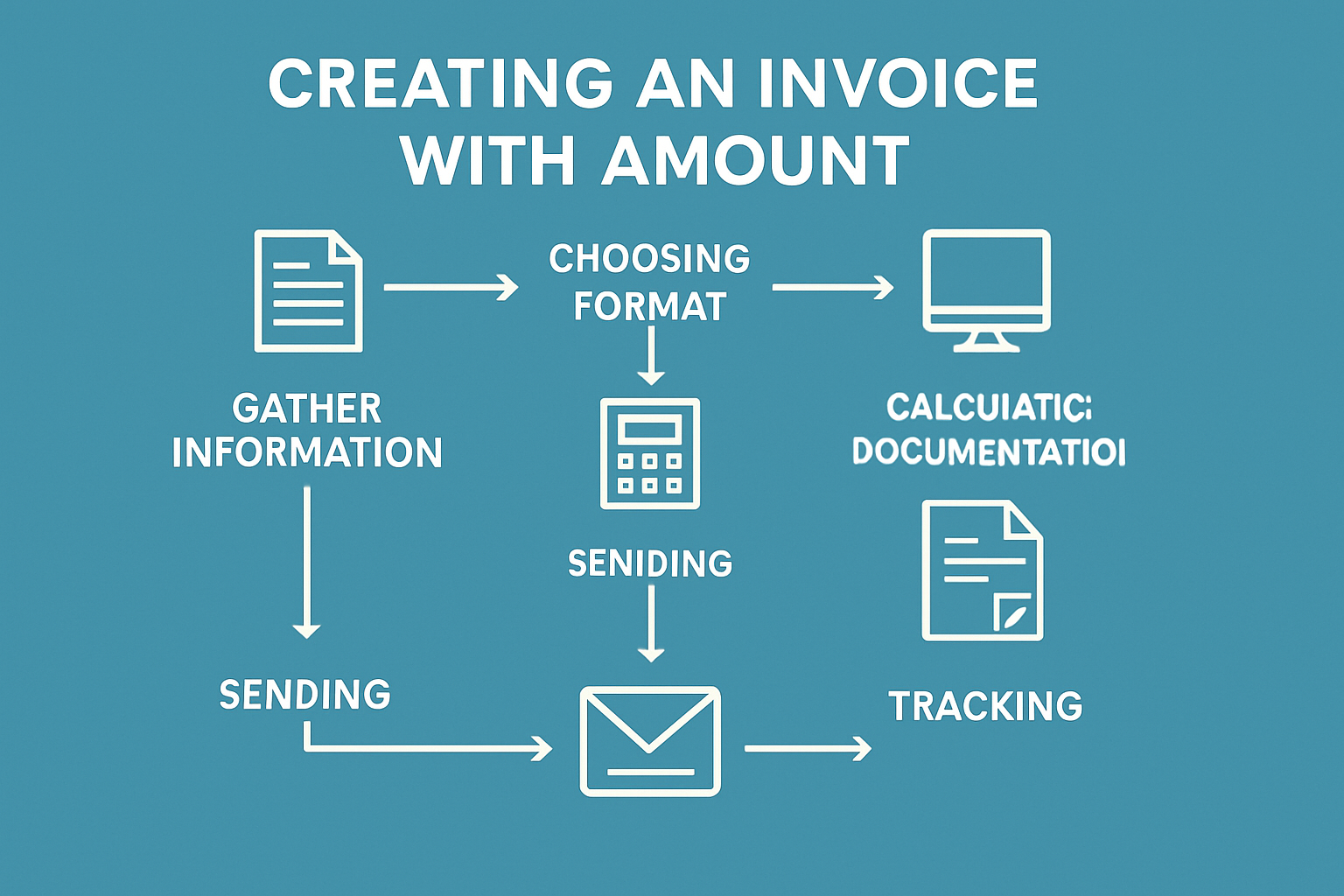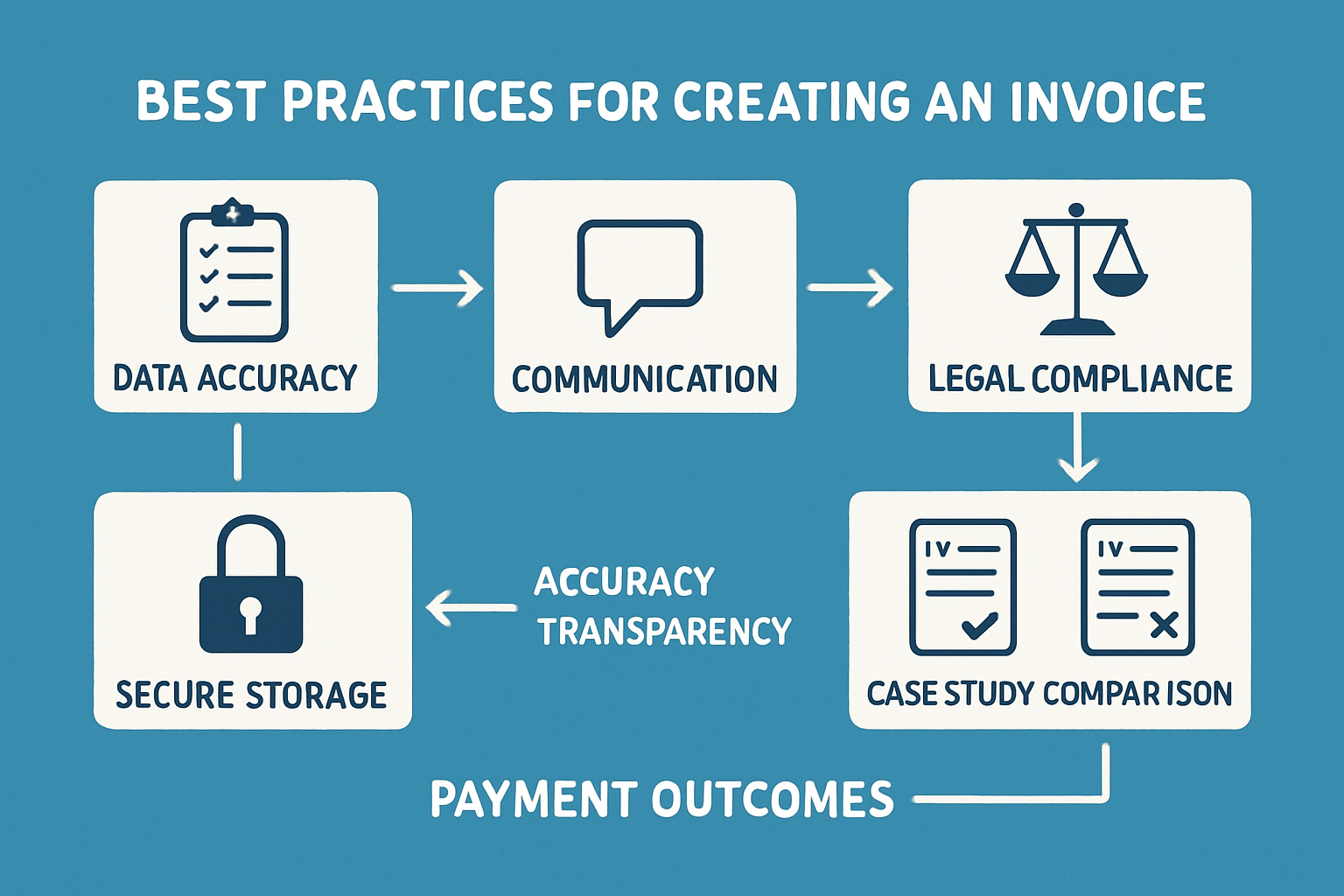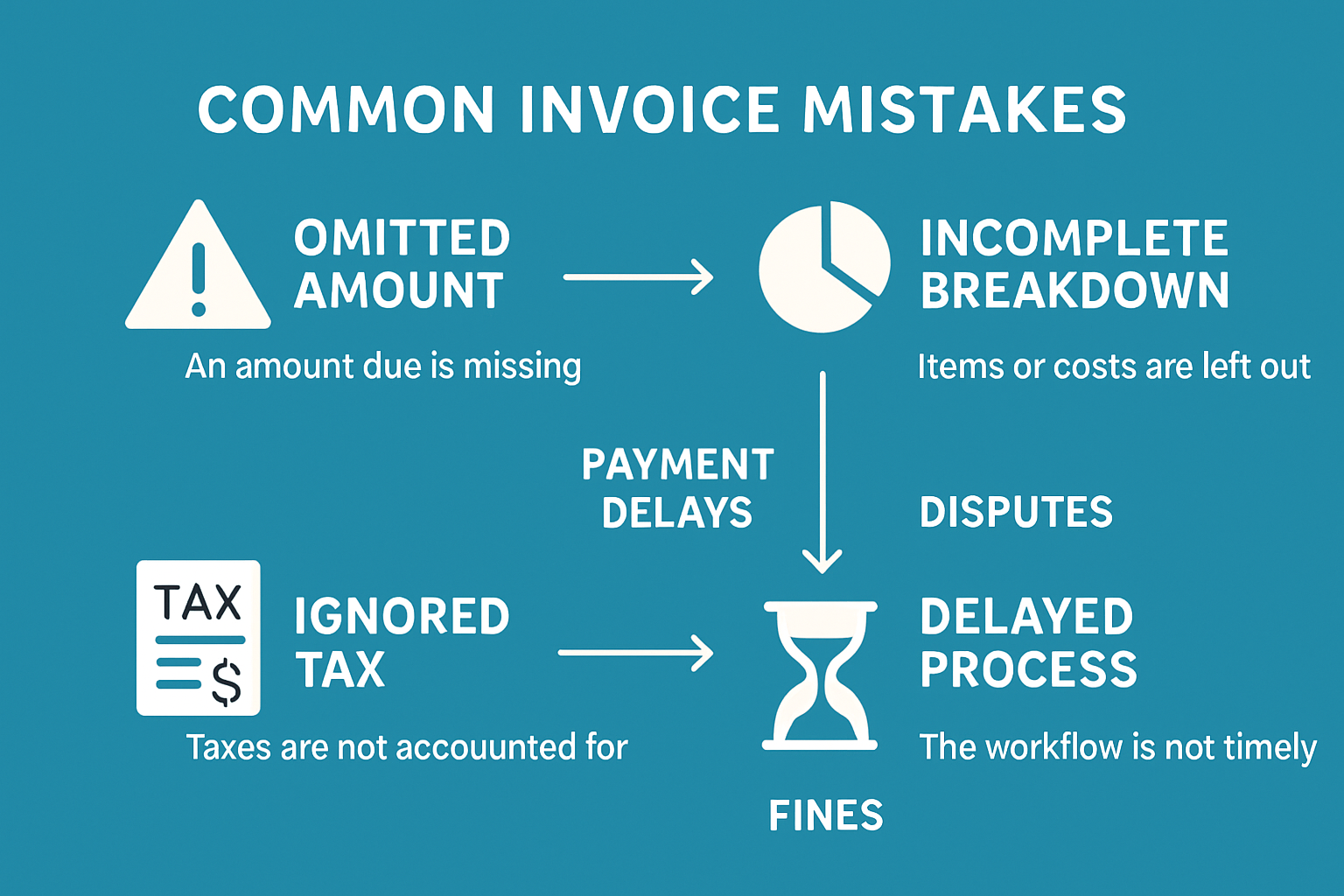Getting paid on time is vital for every business, and it all starts with sending an accurate invoice with amount. In 2025, even small invoicing errors can lead to late payments, compliance headaches, or lost trust. This complete guide walks you through each step, from understanding what “invoice with amount” means to mastering legal rules, best practices, and avoiding common mistakes. Ready to make your invoicing easier, faster, and more professional? Follow along and take control of your cash flow with confidence.

How to Invoice With Amount: A Complete Guide (2025)
Understanding “Invoice With Amount”: Core Concepts and Requirements
Getting the “invoice with amount” right is a non-negotiable part of running a business in 2025. But what does this term really mean, and why is it so important for your company’s cash flow, reputation, and compliance? Let’s break down the core concepts and dive into the essential requirements you need to know.

Definition and Importance of “Invoice With Amount”
An “invoice with amount” is a formal billing document that specifies the exact sum a client owes for products or services delivered. In business and accounting, this clarity is crucial. Invoicing with a clearly stated amount ensures both parties agree on what’s due, minimizing disputes and misunderstandings.
When you fail to provide a precise invoice with amount, you risk delayed payments, eroded client trust, and even regulatory trouble. The difference between an invoice with amount and one without is night and day: only the former provides legal evidence of what’s owed. In fact, inefficient or inaccurate invoicing is a leading cause of cash flow issues, as highlighted by the Impact of Poor Invoice Processing on Cash Flow.
Legal and Regulatory Requirements in 2025
By 2025, new regulations require every invoice with amount to meet strict standards. Tax authorities worldwide now demand digital invoicing, with amounts accurately stated for VAT, sales tax, or GST. Failing to comply can mean heavy fines or audits.
Different countries have their own rules for invoice with amount. For example, the EU mandates e-invoices must show net amounts, tax rates, and totals. The US and Canada have state and federal requirements, while Asia-Pacific regions have rapidly evolving digital invoice laws. Penalties for incorrect invoice with amount entries range from delayed payments to thousands in regulatory fines.
Key Components of an Invoice With Amount
A compliant invoice with amount must include some mandatory fields. Here’s a quick breakdown:
| Mandatory Fields | Optional (Recommended) |
|---|---|
| Amount Due | Project/PO Number |
| Detailed Line Items | Notes or Comments |
| Taxes (VAT/Sales Tax) | Payment Terms |
| Client/Vendor Info | Contact Details |
| Invoice Date/Number | Attachments (e.g., receipts) |
A real-world invoice with amount example will show clear itemized charges, subtotal, applicable taxes, and a final total. Adding optional fields improves transparency and reduces confusion.
Common Use Cases
The need for an invoice with amount spans freelancers, small businesses, and large enterprises alike. In retail, invoices break down product quantities and prices; in SaaS, they detail subscription periods and fees; in consulting, hours worked and rates are itemized.
Statistics show that up to 61% of late payments are linked to invoice errors or missing details—often the amount. Accurate invoice with amount practices are especially vital in industries with complex billing, like construction or IT services, to avoid costly delays and disputes.
Step-by-Step Guide: How to Create an Invoice With Amount
Accurately preparing an invoice with amount is essential for keeping your business finances healthy and your clients happy. Let’s break down the process, step by step, so you can create clear, compliant, and professional invoices every time.

Step 1: Gather Essential Information
Start by collecting all the critical details for your invoice with amount. This includes your business name, address, and contact information, as well as your client’s company details. Double-check that you have the correct billing contact and up-to-date addresses.
Next, outline what you’re billing for. Are you invoicing for products, services, or a combination? Clearly specify the scope of work or list the goods delivered. Having all this information upfront makes the process of creating an invoice with amount much smoother and helps avoid back-and-forth with your client.
Step 2: Choose the Right Invoicing Format
Selecting the best format for your invoice with amount is crucial in 2025, as many businesses are shifting to digital systems. Decide whether you’ll use digital invoices or stick with traditional paper formats. Digital invoices offer faster delivery and easier tracking, which is why they’re becoming the preferred choice.
Explore popular invoicing software or downloadable templates to streamline the process. Ensure your chosen format is compatible with your client’s systems. This compatibility is vital for seamless processing and prevents delays when you send your invoice with amount.
Step 3: Calculate and Enter the Amount Accurately
Now, it’s time to do the math. Itemize each product or service provided, assigning the correct price to each line. Add up the totals, then include any applicable taxes, discounts, or shipping fees. Always double-check your calculations to ensure your invoice with amount reflects the true cost.
Mistakes in this step can lead to disputes or payment delays. For tips on common calculation errors and how to avoid them, see Common Invoicing Errors and Prevention Strategies. Ensuring accuracy here boosts your professionalism and helps maintain client trust.
Step 4: Add Supporting Details and Documentation
Supporting documentation adds credibility to your invoice with amount. Attach receipts, signed contracts, or timesheets as needed. This documentation helps your client verify the charges and speeds up the approval process.
Include clear payment terms, such as due dates and accepted payment methods, directly on the invoice. Adding a brief note—like a thank you message or special instructions—can also enhance your client’s experience. The more transparent your invoice with amount, the fewer questions and delays you’ll encounter.
Step 5: Review, Approve, and Send the Invoice
Before you send your invoice with amount, take a few moments to review everything. Check for typos, verify that all required fields are filled, and confirm that the amount is correct. In larger organizations, an internal approval workflow may be necessary.
Decide how you’ll send the invoice: email, client portal, or integrated accounting software. Digital delivery is often faster and provides a record of when your invoice with amount was sent and received. Always keep a copy for your records.
Step 6: Track, Follow Up, and Record Payments
Once your invoice with amount has been sent, don’t let it disappear into a black hole. Use invoicing software or a simple tracking system to monitor invoice status—whether it’s sent, viewed, or paid.
Set up automated reminders to follow up on outstanding payments. Recording payments as soon as they’re received helps keep your books accurate and ensures you know which clients might need an extra nudge. Staying on top of your invoice with amount is key to healthy cash flow.
Example Walkthrough: Creating a Sample Invoice With Amount
Let’s walk through a simplified example of an invoice with amount for freelance graphic design work:
Invoice Number: 2025-001
Date: 2025-02-10
Bill To: Acme Corp, 123 Main St.
Description: Logo Design (10 hours @ $50/hr)
Subtotal: $500
Tax (10%): $50
Total Amount Due: $550
Payment Terms: Net 15
Notes: Thank you for your business!
This sample invoice with amount includes all key fields: client/vendor info, itemized charges, taxes, and total. By following the previous steps, you ensure each invoice with amount you send is complete, accurate, and professional.
Best Practices for Accurate and Compliant Invoicing
Accurately managing every invoice with amount is essential for both financial health and legal compliance. By following best practices, you reduce costly errors, improve relationships, and ensure a smooth payment process. Let’s break down the key strategies for 2025.

Ensuring Data Accuracy and Consistency
Data accuracy is the foundation of any invoice with amount. Small mistakes can lead to disputes, delayed payments, or even legal penalties. Always double-check amounts, line items, and client details before sending invoices.
Common sources of errors include manual entry, outdated templates, and miscommunication between teams. To avoid these, use standardized templates and encourage regular audits. Automated tools can flag inconsistencies, reducing human error.
Consistent formatting and clear calculations help clients process your invoice with amount quickly, minimizing back-and-forth and speeding up approval.
Clear Communication and Transparency
Transparent communication is vital when issuing an invoice with amount. Clients should easily understand what they are being charged for, why, and how to pay.
Include detailed line items, clear payment terms, and your contact information for questions. This openness builds trust and reduces confusion.
If a client queries an invoice with amount, respond promptly and provide supporting documentation. Proactive communication can prevent disputes and keep your cash flow healthy.
Staying Up-to-Date With Legal Changes
Regulations impacting invoice with amount requirements are evolving rapidly. Tax rates, digital invoicing laws, and cross-border compliance can change yearly.
Monitor updates from tax authorities and industry associations. Subscribe to newsletters or use invoicing software that automatically updates for legal changes.
Adapting your invoice with amount template as soon as laws shift keeps you compliant and avoids penalties. It also shows clients you’re committed to professional standards.
Secure Storage and Record-Keeping
Proper storage of every invoice with amount is both a legal and business necessity. Secure digital archiving protects sensitive data and makes retrieval easy.
Retention periods vary by industry and location. Here’s a quick comparison:
| Industry | Typical Retention Period |
|---|---|
| General Business | 7 years |
| Healthcare | 10 years |
| Financial | 5–7 years |
Encrypt files, use access controls, and back up your data regularly. Clear record-keeping supports audits and resolves payment disputes efficiently.
Real-World Examples and Case Studies
The impact of managing an invoice with amount accurately is measurable. Businesses that follow these best practices report faster payment cycles and fewer disputes.
For example, adopting e-invoicing solutions has been shown to reduce late payments and boost efficiency. According to E-Invoicing's Role in Addressing Late Payments, automation and real-time tracking significantly improve turnaround times.
Case studies reveal that companies prioritizing accurate invoice with amount practices see improved client trust and more predictable cash flow.
Common Mistakes When Invoicing With Amount—and How to Avoid Them
Mistakes on an invoice with amount can seem minor but have a major impact on your business. Understanding where businesses go wrong helps you avoid costly delays, disputes, or even penalties. Let’s break down the most common pitfalls and how to steer clear of them.

Omitting or Misstating Amounts
Leaving out the full amount or entering it incorrectly is one of the most frequent errors when preparing an invoice with amount. These mistakes can happen due to manual entry, distractions, or outdated templates.
- Causes: Typos, copy-paste errors, or miscommunication.
- Consequences: Payment delays, confusion, and potential loss of trust.
- Example: A missing zero turns $1,000 into $100, leading to underpayment and follow-up hassles.
Manual processes are especially prone to such errors. According to Manual vs. Automated Invoice Processing Statistics, manual invoice handling can double error rates compared to automated tools. Always double-check every invoice with amount before sending.
Incomplete Breakdown of Charges
Clients need to see exactly what they’re paying for. Failing to provide a detailed breakdown on your invoice with amount can spark disputes and slow down approval.
- Missing line items or vague descriptions.
- Bundling services or products into one lump sum.
- Omitting tax or shipping charges.
When clients don’t understand the charges, they’re more likely to question the invoice. This clarity is key to smooth payments and fewer back-and-forth emails.
Ignoring Tax and Regulatory Requirements
Tax laws and digital invoicing regulations are evolving fast. Omitting required tax details or miscalculating them on your invoice with amount can result in non-compliance.
- Risks: Audits, fines, and legal trouble.
- Example: Sending an invoice to an EU client without correct VAT information.
- Solution: Stay updated with the latest rules and ensure your templates are compliant.
Ignoring these details doesn’t just cause headaches—it can cost real money.
Delayed or Unclear Invoicing Processes
Late, unclear, or inconsistent invoicing slows down your cash flow. If your invoice with amount is sent long after delivery, or the process is unclear, clients may deprioritize your payment.
- Common causes: Manual tracking, lack of reminders, or confusing layouts.
- Impact: Strained relationships and longer wait times for funds.
Automated invoicing solutions can help you streamline delivery and keep payments on track.
Lessons Learned: Real-World Scenarios
Consider these real-world examples:
- A freelancer omits a discount, causing overbilling and client frustration.
- An SMB uses an outdated template, missing new tax fields, and faces a compliance fine.
- A consulting firm’s invoice with amount lacks service details, leading to a month-long payment dispute.
Learning from these mistakes means reviewing every invoice, using the right tools, and staying alert to legal changes. Avoiding these pitfalls ensures smoother transactions and healthier business relationships.
Leveraging Technology and Automation for Invoicing With Amount
Modern businesses can no longer afford to rely on manual processes for managing invoices. Leveraging technology is now essential for accuracy, speed, and compliance—especially when it comes to the critical details in an invoice with amount. Automation not only streamlines workflows but also minimizes human error, giving your business a competitive edge.
Benefits of Digital Invoicing Tools in 2025
Digital tools have redefined how companies handle every invoice with amount. These platforms offer instant generation, easy customization, and seamless sharing. With cloud-based solutions, your team can collaborate in real time, even across continents.
Automation ensures that each invoice with amount is calculated accurately, reducing manual entry mistakes. Plus, digital tools often integrate with accounting platforms, making reconciliation and reporting much smoother.
Other benefits include faster payment processing, better tracking, and built-in compliance features. As a result, businesses see improved cash flow and fewer disputes over invoice with amount details.
Features to Look For in Invoicing Software
Choosing the right software for invoice with amount tasks means knowing which features matter most. Look for automated calculations, real-time error detection, and compliance checks to ensure every invoice with amount meets legal standards.
Here’s a quick comparison of key features to consider:
| Feature | Why It Matters for Invoice With Amount |
|---|---|
| Automated Calculations | Ensures totals and taxes are always correct |
| Compliance Monitoring | Keeps invoices legally sound |
| Customizable Templates | Adapts to business and client needs |
| Integration Capabilities | Syncs with accounting and payment platforms |
| Error Alerts | Flags inconsistencies in invoice with amount |
A robust tool will help you create, send, and track every invoice with amount without missing a beat.
AI and Machine Learning in Invoice Data Extraction
AI-driven tools are transforming the way businesses manage invoice with amount details. Machine learning algorithms can read, extract, and verify data from uploaded receipts, contracts, or scanned documents. This reduces manual data entry and speeds up the process.
For example, some solutions automatically detect discrepancies in amounts or flag missing fields before sending an invoice with amount. This proactive error detection keeps your billing process smooth.
Interested in how AI can streamline your invoicing? Explore Intuit’s AI-powered invoicing solutions for more details.
Security and Data Privacy Considerations
When sending an invoice with amount, protecting sensitive client and company data is crucial. Digital invoicing tools offer advanced security features like encryption and multi-factor authentication.
Consider these best practices:
- Use platforms that comply with GDPR or local data laws for every invoice with amount.
- Store invoices in encrypted databases.
- Limit access to sensitive invoice with amount records to authorized personnel only.
By prioritizing data privacy, you not only protect your business but also build trust with clients.
Future Trends: The Evolving Landscape of Invoicing With Amount
The landscape for invoice with amount is rapidly changing. Over the next five years, expect deeper automation, smarter AI verification, and seamless integration with payment gateways.
Upcoming trends include real-time tax updates, blockchain-secured invoices, and global compliance modules. Staying current with these innovations will help your business maintain accuracy and agility in every invoice with amount.
To stay ahead, regularly review your tools and processes. Embrace new technologies and adapt to regulatory shifts to keep your invoicing practices future-proof.
Now that you know how crucial accurate invoicing is for getting paid on time and staying compliant, why not make the process even easier? We’ve talked about the headaches of manual data entry and the risks of errors, but you don’t have to do it all yourself. With AI-powered tools, you can extract key invoice details—like amounts and line items—in seconds, no templates needed. If you’re ready to streamline your workflow and reduce mistakes, give Free Invoice Parser a try. It’s a smart way to boost your invoicing accuracy and save valuable time.
